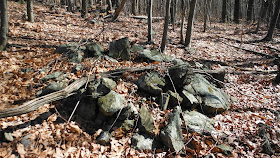It was just a month ago that I was waiting for the snow to
melt around here.
And then just a few days later, I stopped at closer car lot
to capture a photo or two of the progressive snow melting off of that same
outcrop, thinking I should go back up there some time to the top of that out
crop because I couldn’t recall that row of stones along the edge of that sort of steep
ridgetop that sort of surprised me by showing up under that melting snow.
And I will add two images and a few words, eight years later on March 24, 2022:
"That's a snow covered Qusukqaniyutôk leading up to a bedrock outcrop, connecting to other Qusuqaniyutôkansh or “stone walls.” If there are "metates and manos" to be found within the enclosure, then whoever constructed these "rows of stones" was "gathering something and then processing something in this fire tended garden spot," a reasonable person might conclude..."
Interesting stuff along the way (above), I ended up on top of
that outcrop, amid boulders and stones, looking west, out onto the Hamburger Edge of Watertown
CT:
Like this in Bing Maps, the Bird's Eye View with east at the top:
Or take a look on your own screen:
My labels for this section:
The 1965 aerial, east also at top:
It will come to me, just where these rows show up someday...
On the ridge top:
NW above, SSW below
Two or three person sized boulders, and many largish cobbles, make up the row.
Precarious footing on the business side of the drop, but maybe some stacking?
I had to get a few close ups of some face-like or head-like stones:
And odd sorts of choices for stacking some stones:
I could easily draw some eyes here, but the shadows help illustrate the two centered stones here as appearing head-like - one with a sharp beak maybe:
Mandatory fuzzy close-up of the beaky one:
More odd choices (for an Anglo-European farm fence):
But perhaps a good choice for a bird effigy in a pre-contact row of stones:
Possible turtle below, legs extended as if moving, ready to push back:
Another testudinate placement possibly, head and flipper:
Something bowl-like?
I'll wonder about this one a while, the shape, the flat stone and wedge:
A little stack on the flat side:
More interesting stacking:
(Kinda like floating in the air:)
Bird-like again:
Right by a stone pile and a stained stone you may have seen before:
Another little stack:
The Corner:
Looking up and east:
Possible smile:
Possible beak and eyes on a stone placed "just so:":
Another metate-like deal with a big fat crusher?
Guess this one:
A High Point:
Note the (bad photo of) the reddish stone:
More atypical stacking - for a farmer:
(Note the stone much like the shadowy eyed one by the beaked stone way back toward the beginning:
Bear?
Another metate-like stone and possible mano:
The bottom is sort of rough though...
More artistic stacking of some unusual stones - little beaked bird in there, perhaps:
(wish I didn't cut off the tip of the beak in the close up)
Corner again:
More stone piles:




























































































